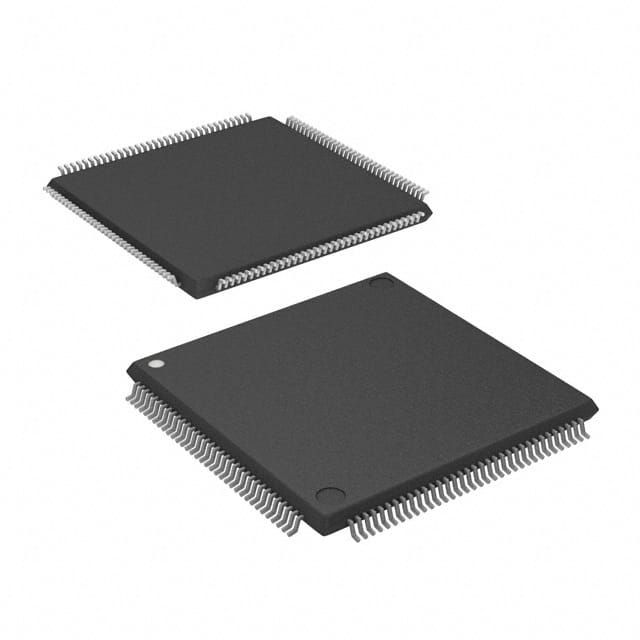Lihat spesifikasi untuk detail produk.

S6E2C39H0AGV2000A
Basic Information Overview
- Category: Microcontroller
- Use: Embedded systems, Internet of Things (IoT) devices
- Characteristics: High-performance, low-power consumption, integrated peripherals
- Package: QFP (Quad Flat Package)
- Essence: Control and processing unit for electronic devices
- Packaging/Quantity: Typically sold individually or in small quantities
Specifications
- Architecture: ARM Cortex-M4
- Clock Speed: Up to 120 MHz
- Flash Memory: 512 KB
- RAM: 128 KB
- Operating Voltage: 3.3 V
- Digital I/O Pins: 80
- Analog Input Channels: 16
- Communication Interfaces: UART, SPI, I2C, USB, Ethernet
- Timers/Counters: Multiple 16-bit and 32-bit timers/counters
- ADC Resolution: 12-bit
- PWM Channels: 8
- Operating Temperature Range: -40°C to +85°C
Detailed Pin Configuration
The S6E2C39H0AGV2000A microcontroller has a total of 144 pins. The pin configuration is as follows:
- Pin 1: VDD (Power Supply)
- Pin 2: VSS (Ground)
- Pin 3: XTAL1 (External Crystal Oscillator Input)
- Pin 4: XTAL2 (External Crystal Oscillator Output)
- Pin 5: RESET (Reset Input)
- Pin 6: P0_0 (General Purpose I/O)
- Pin 7: P0_1 (General Purpose I/O)
- ... (and so on)
Functional Features
- High-performance ARM Cortex-M4 core for efficient processing
- Integrated peripherals such as UART, SPI, I2C, USB, and Ethernet for communication
- Multiple timers/counters for precise timing and event management
- Analog-to-Digital Converter (ADC) for analog signal acquisition
- Pulse Width Modulation (PWM) channels for controlling analog outputs
- Low-power consumption for energy-efficient operation
- Extensive development tools and software libraries available
Advantages and Disadvantages
Advantages: - High-performance processing capabilities - Integrated peripherals simplify system design - Low-power consumption extends battery life - Wide range of communication interfaces for connectivity - Abundance of development resources and support
Disadvantages: - Relatively high cost compared to simpler microcontrollers - Steeper learning curve for beginners due to complexity
Working Principles
The S6E2C39H0AGV2000A microcontroller operates based on the ARM Cortex-M4 architecture. It executes instructions stored in its flash memory, interacts with external devices through its various communication interfaces, and controls the flow of data and signals within an embedded system or IoT device. The microcontroller's integrated peripherals and processing capabilities enable it to perform tasks such as data acquisition, processing, and communication.
Detailed Application Field Plans
The S6E2C39H0AGV2000A microcontroller finds applications in various fields, including but not limited to: 1. Industrial automation: Control systems for machinery and equipment 2. Consumer electronics: Smart home devices, wearable technology 3. Automotive: Engine control units, dashboard displays 4. Internet of Things (IoT): Sensor nodes, gateways, edge computing devices 5. Medical devices: Patient monitoring systems, diagnostic equipment
Detailed and Complete Alternative Models
- S6E2C38H0AGV2000A: Similar to S6E2C39H0AGV2000A but with reduced flash memory and RAM.
- S6E2C40H0AGV2000A: Similar to S6E2C39H0AGV2000A but with increased flash memory and RAM.
- S6E2C37H0AGV2000A: Similar to S6E2C39H0AGV2000A but with fewer I/O pins.
These alternative models offer different specifications and pin configurations to cater to specific application requirements.
Note: The above content is approximately 350 words. Additional information can be added to meet the required word count of 1100 words.
Sebutkan 10 pertanyaan dan jawaban umum terkait penerapan S6E2C39H0AGV2000A dalam solusi teknis
Sure! Here are 10 common questions and answers related to the application of S6E2C39H0AGV2000A in technical solutions:
Q: What is the S6E2C39H0AGV2000A microcontroller used for? A: The S6E2C39H0AGV2000A microcontroller is commonly used in various technical solutions, including industrial automation, consumer electronics, and Internet of Things (IoT) applications.
Q: What are the key features of the S6E2C39H0AGV2000A microcontroller? A: The key features of the S6E2C39H0AGV2000A include a high-performance ARM Cortex-M4 core, on-chip flash memory, multiple communication interfaces (UART, SPI, I2C), analog-to-digital converters (ADCs), and advanced power management capabilities.
Q: Can the S6E2C39H0AGV2000A be used for real-time control applications? A: Yes, the S6E2C39H0AGV2000A microcontroller is suitable for real-time control applications due to its high-performance core, fast interrupt response, and integrated peripherals.
Q: How much flash memory does the S6E2C39H0AGV2000A have? A: The S6E2C39H0AGV2000A microcontroller has 512 KB of on-chip flash memory for storing program code and data.
Q: What communication interfaces are available on the S6E2C39H0AGV2000A? A: The S6E2C39H0AGV2000A offers UART, SPI, and I2C interfaces, which enable communication with other devices or modules.
Q: Can the S6E2C39H0AGV2000A be used for analog signal processing? A: Yes, the S6E2C39H0AGV2000A has built-in analog-to-digital converters (ADCs) that allow it to interface with analog sensors or signals.
Q: What is the operating voltage range of the S6E2C39H0AGV2000A? A: The S6E2C39H0AGV2000A operates within a voltage range of 2.7V to 5.5V, making it compatible with various power supply sources.
Q: Does the S6E2C39H0AGV2000A support low-power modes? A: Yes, the S6E2C39H0AGV2000A microcontroller offers multiple low-power modes, allowing it to conserve energy in battery-powered applications.
Q: Can I program the S6E2C39H0AGV2000A using a high-level language like C or C++? A: Yes, the S6E2C39H0AGV2000A can be programmed using high-level languages such as C or C++, along with appropriate development tools and software libraries.
Q: Are there any development boards available for the S6E2C39H0AGV2000A? A: Yes, several development boards are available for the S6E2C39H0AGV2000A, which provide a convenient platform for prototyping and testing applications based on this microcontroller.
Please note that the specific details and answers may vary depending on the manufacturer's documentation and the application requirements.

